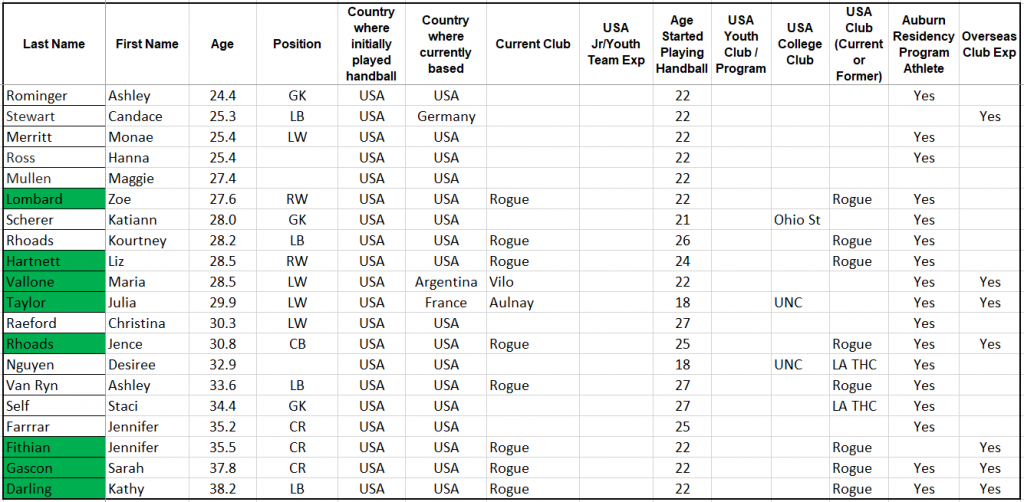
Previously, I provided top level overview of every American female handball player in the world (around 200 athletes). This part reviews the current women’s national team player pool, where they developed their handball skills and asks some philosophical questions about where the U.S. should go from here.
The US. Women’s Sr National Team Player Pool
USA Team Handball lists 35 athletes as officially being part of its Women’s Sr Team Player Pool (The website indicates that it was last updated on November 14th, 2018).
There’s a lot of ways to group these athletes for analysis, but I’ve chosen to highlight a few key data points.
- Athletes are split in to two key cohorts (Americans that first played handball in another country/Americans that first played handball in the U.S.): I’d like to again emphasize that splitting these two groups is not meant to be divisive. Every one of these athletes is an American. That being said, any meaningful discussion of the U.S. talent pool has to recognize that the development of these two cohorts is significantly different. (For more insight into expat Americans read this series (Part 1, Part 2, Part 3)
- Athletes are then listed by age
- Athletes selected for the 2019 PANAM Games are highlighted in green

A few observations:
- Compared to the U.S. Men’s player pool, the U.S. Women’s player pool has fewer (15 total) Expat Americans available
- I would assess that in relative terms the overall quality of the U.S. Women’s expat player pool is a rung or two below that of the U.S. Men. Some respectable talent, but no one at the level of Ian Hueter, Abou Fofana or Rene Ingram.
- 5 expat Americans participated in the Auburn Residency Program. I would assess that the practice of sending European based players to the U.S. as highly questionable for a couple of reasons. 1) Quality training environments with regular competition are readily available in Europe. 2) If a player who has already been training for several years in Europe still needs extra refinement of their handball skills then they are likely not a strong national team prospect.
- There is less participation (compared to the U.S. Men) in Youth and/or Jr national team competitions. This, however, is likely due to the reality that there are fewer women available and therefore it has been challenging to even field a roster.
U.S. Player Pool (Americans that First Played Handball in the U.S)

(Note: The ages in the “age started playing handball” are estimates based on when and where athletes started playing.)
A few observations:
- The 5 year Auburn Residency Program (2013-2018) accounts for 22 of the 35 athletes in the U.S. player pool. (17 stateside, plus 5 athletes that initially started playing handball in Europe).
- Several of the athletes listed in this pool are not even playing handball on a regular basis. Some have shifted to beach handball while others simply don’t live anywhere near a handball club that they could practice with.
- In terms of “diamonds in the rough” I would assess that only Jence Rhoads fits into that category. At age 30, however, she is clearly older (for her current level of handball skills development) than desired.
- Only 4 athletes have any type of collegiate experience. This, however, is simply reflective of the reality that there are only 3 women’s college programs in the U.S.
Talent Beyond the Current Pool
There are also several athletes that currently aren’t in the U.S. Sr Team Pool. This would include all of our college athletes as well as any athletes that participated in the recent IHF Trophy competition in Montreal. I don’t have the demographics for these athletes, but having attended the last two collegiate championships and viewed several IHF Trophy matches, most of these athletes are clearly a rung or two below the current Sr National Team player pool.
What We Have: A Mostly Empty Cupboard
With the U.S. Men it was relatively easy to assess the handball skills and ages of athletes in the current player pool and to project which athletes likely had a national team future through 2024. There was a natural grouping of athletes that were a solid notch above the rest.
With the U.S. Women’s current player pool, however, I don’t see a similar grouping of athletes that are demonstrably better than the rest. Instead, I see a few stand outs and then a lot of mediocrity. While several athletes are either older or less talented than desired I could still make a case for virtually every athlete in the pool making a future roster.
But, “current player pool” is italicized for a reason. Because this pool consists mostly of athletes with modest raw talent and/or older athletes it’s not hard to envision new athletes with zero handball experience being trained up and quickly entering the player pool.
However, this sort of thinking is getting way ahead of the methodology of
And, while it’s tempting to immediately start thinking of solutions to our empty cupboard of a player pool a lot of thought as to “What we want” is needed first. Because while the U.S. could recruit some quality athletes that have never played handball and provide them some intensive training to restock the cupboard some big questions need to be asked and answered first. Those questions are
- Is a “quick fix” national team focus the best use of limited resources?
- How likely is it that such a team will be able to beat Brazil at the 2023 PANAM Games to secure 2024 Olympic qualification?
- Does it make more sense to focus on grass roots development with a timeline target of maximizing performance at the 2028 Olympic Games in Los Angeles?
- Or, are the demographics and structure for women’s sport in the U.S. too challenging for a grass roots handball focus?